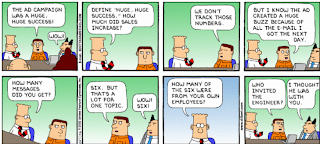Dive Brief:
· Solve Media, a company that places ads
in captchas, has reported that 51% of all U.S. web traffic was fraudulent in
Q3.
· That figure is an 8% increase from Q2
and the first time fraudulent traffic has hit more than 50%, according
to Solve’s Quarterly Bot Traffic Market Advisory.
· Solve Media also reported an uptick in
fraudulent traffic on mobile, going from 22% in Q2 to 27% in Q3.
Willie Sutton summed it the current fraudulent
web traffic problem best. 50 years ago. "Why do you rob
banks?" "Because that is where the money
is..."
I suppose that sentiment sums up a certain
percentage of society. However I am especially
disappointed because digital fraud has made me line of work a little harder. While the system is not fool proof, TV
advertising, by and large, is “as advertised”.
On network TV you buy an ad on one of the four networks, receive a schedule
and can flip the channel and see you ad running “as advertised”.
With digital marketing products like
targeted display, it is a little more complicated. You
place your buy through a network or exchange and it is possible that your ad
will run on one of hundreds of web sites, with no “schedule” that lets you know
to tune in at 10:08 and see your ad.
You rely on a report that your vendor (agency,
ad network, exchange) provides that shows X number of impressions ran, Y number
of clicks, etc.
This is where transparency comes
in. To be fully transparent, this report
would also include site/URL level reporting.
Your behavioral network reported
100,000 impressions.
32,405 impressions ran on AAAA.com with
32 clicks
21,207 impressions ran on BBBB.com with
73 clicks, etc.
But many networks are not
transparent. They choose to only provide
summary level detail, not site level. This
is where the Willie Sutton’s of the digital world play. If you
cannot access the URL where your ad runs, how do you know the site and the
traffic is legitimate?
Ad networks include sites on their list
based on a variety of factors, like number of unique visitors, page views,
demographics, etc.
With today’s technology, it is easy
enough to build a web site with little or no content, but with multiple ad
placements, and then program a bot to pound away visiting the web site and
driving up metrics and clicks. There is
little to no human traffic, it is all fabricated. But you can run a report that documents
100,000 page views, 29,212 unique visitors, etc.
Most vetting today is done by algorithms,
not humans. So while human intervention
would help, it will not solve the problem.
(And for some, there is a disincentive to discover this truth. If you are selling a 0.89% CTR, do you really
want to know?)
The most powerful tool we have to
ferret out these dummy sites and networks is sunlight.
Full discloser brings all the secrets
out into the daylight for all to see.
There will still be sites that attempt to game the system, but the more
access you, the advertiser, have to this list of sites, the better you can
decide on whether or not the individual site is right for your campaign.
Many networks are offering full
discloser and are being rewarded by the additional revenue advertisers are
channeling their way. The digital
ecosystem is moving in the direction of full disclosure, but we (the marketers
and advertisers) need to expedite the process by only placing our advertising
dollars with the networks that report our campaigns in full sunlight.
“Aim at the sun, and you may not reach it; but your
arrow will fly far higher than if aimed at an object on a level with yourself.”
--
Joel Hawes
Pixalate Cracking Down On Click Fraud, Bot Traffic and Ad Viewability






